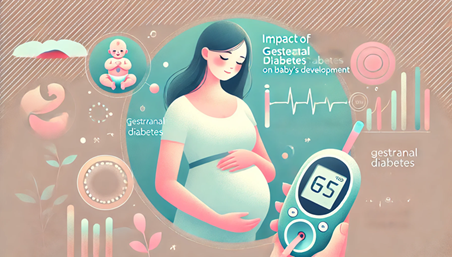Gestational Diabetes: A Complete Guide for Expecting Moms

Gestational diabetes is a condition that affects pregnant women and occurs when the body cannot produce enough insulin to meet the increased needs during pregnancy. This leads to elevated blood sugar levels, which can pose risks to both the mother and the baby. Understanding gestational diabetes is crucial for ensuring a healthy pregnancy and minimizing complications.
What Causes Gestational Diabetes?
Gestational diabetes typically develops during the second or third trimester of pregnancy. Several factors can contribute to its onset:
- Hormonal Changes: During pregnancy, the placenta produces hormones that can interfere with the action of insulin. As the pregnancy progresses, the body may struggle to keep up with the increased insulin demand.
- Risk Factors: Women at higher risk include those who are overweight, have a family history of diabetes, have previously given birth to a large baby, or have had gestational diabetes in previous pregnancies. Age is also a factor, with women over 25 being more susceptible.
- Unhealthy Lifestyle: A lack of physical activity and a diet high in sugar and refined carbohydrates can increase the risk of developing gestational diabetes.
Symptoms of Gestational Diabetes
Many women with gestational diabetes may not experience noticeable symptoms. However, some potential signs include:
- Increased thirst
- Frequent urination
- Fatigue
- Nausea
- Blurred vision
Because these symptoms can overlap with typical pregnancy discomforts, it is essential for pregnant women to undergo routine screening for gestational diabetes, usually around the 24th to 28th week of pregnancy.
Diagnosis and Testing
Gestational diabetes is diagnosed through a glucose tolerance test. The process typically involves:
- Initial Screening: A blood sample is taken to measure blood sugar levels after fasting.
- Glucose Challenge Test: If initial results are abnormal, a more thorough test is conducted. The patient consumes a sugary drink, and blood sugar levels are tested at intervals to assess how the body processes glucose.
Managing Gestational Diabetes
Management of gestational diabetes is crucial to minimize risks for both mother and baby. Here are some strategies:
- Healthy Eating: A well-balanced diet that focuses on whole foods, including fruits, vegetables, whole grains, lean proteins, and healthy fats, can help regulate blood sugar levels. Limiting refined sugars and carbohydrates is essential.
- Regular Exercise: Physical activity helps improve insulin sensitivity and can aid in maintaining healthy blood sugar levels. Pregnant women should consult their healthcare provider about safe exercise options.
- Monitoring Blood Sugar Levels: Women with gestational diabetes will often need to monitor their blood sugar levels at home using a glucometer. This helps ensure levels remain within a healthy range.
- Medication: In some cases, dietary and lifestyle changes may not be enough to manage blood sugar levels. Healthcare providers may prescribe insulin or other medications as needed.
Risks of Gestational Diabetes
If left unmanaged, gestational diabetes can lead to several complications, including:
- For the Mother: Increased risk of high blood pressure, preeclampsia, and a higher likelihood of developing type 2 diabetes later in life.
- For the Baby: Higher risk of excessive birth weight, premature birth, respiratory issues, and low blood sugar after birth.
Conclusion
Gestational diabetes is a manageable condition with the right approach. Regular screenings, a healthy lifestyle, and close communication with healthcare providers can help ensure a healthy pregnancy and delivery. If you suspect you might be at risk or have been diagnosed with gestational diabetes, don’t hesitate to reach out to your healthcare provider for guidance and support.


